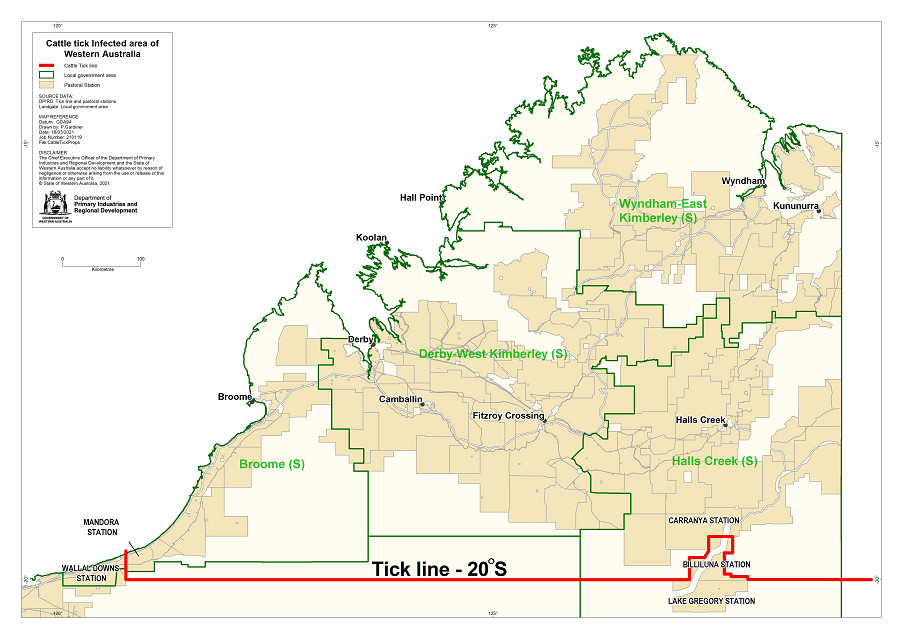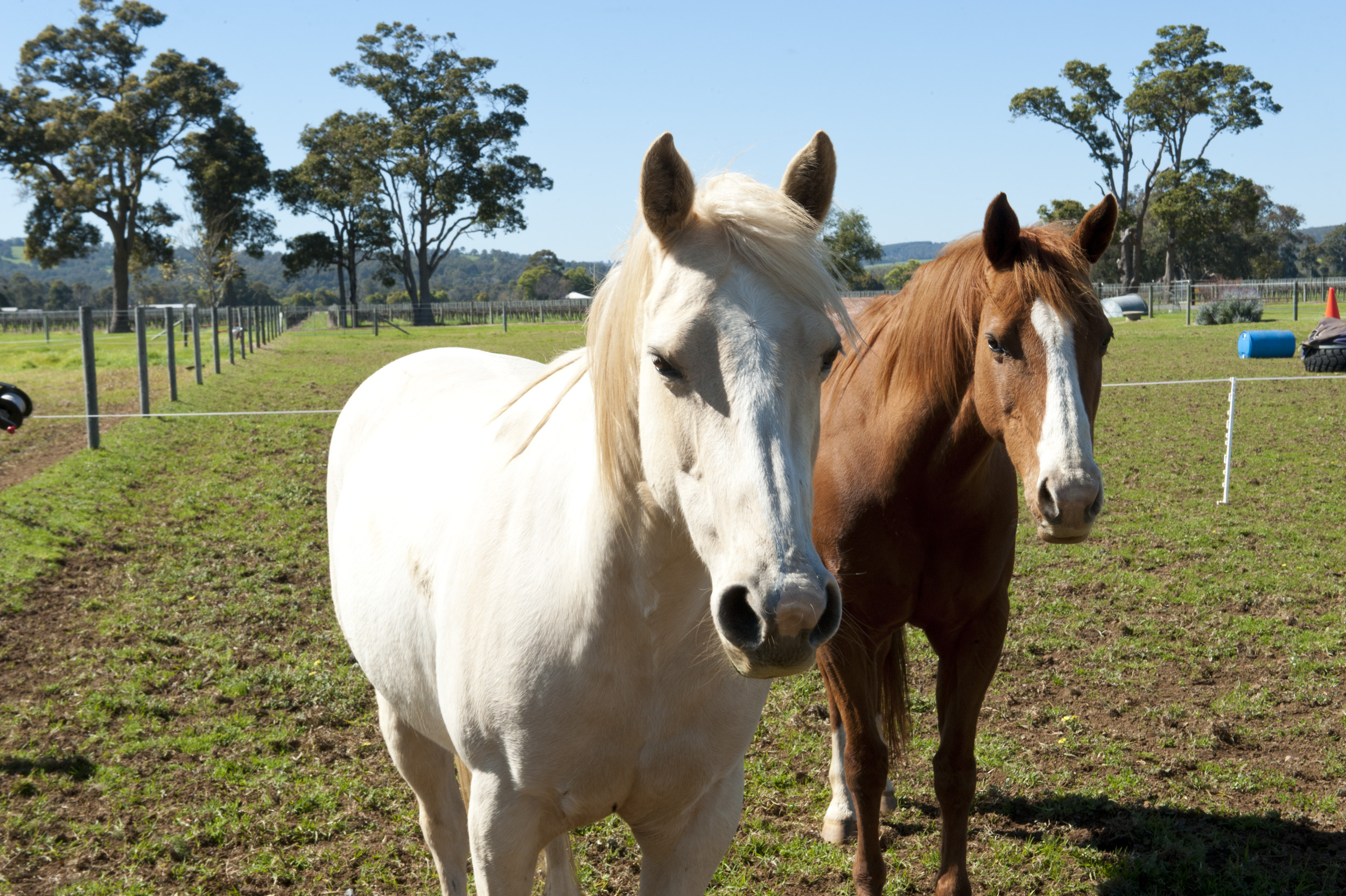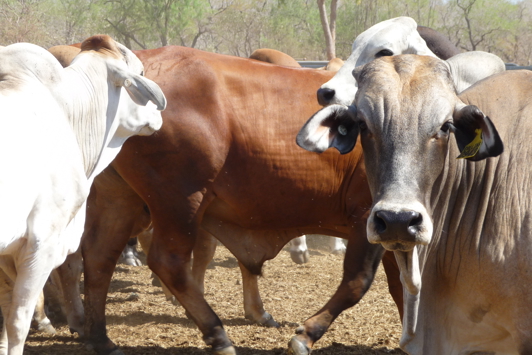The WA cattle tick control program aims to:
- prevent the entry of cattle ticks into WA (import requirements)
- contain cattle ticks within specific zones, for example within the cattle tick-infected area of WA (see the map below)
- reduce the risk of cattle tick spreading to cattle tick-free areas of WA (that is, below the ‘tick line’ in WA), and
- prevent the spread of strains of cattle tick that are resistant to commonly used treatments (acaricide resistance).
Cattle tick (Boophilus microplus)
Cattle tick (Boophilus microplus) is an external parasite that is endemic in higher rainfall areas of northern Australia and can cause direct and indirect production losses. For example, infested cattle can lose condition due to ‘tick worry’ and loss of blood. Cattle, buffalo and deer are favoured hosts whereas horses, sheep, goats, camels and camelids usually have very few ticks.
WA has cattle tick-infested and cattle tick-free areas. Cattle tick is a declared pest under Section 22(2) of the Biosecurity and Agriculture Management Act 2007 as a C1 (Exclusion) organism within the cattle tick-free area of WA.
The cattle tick-infested area is separated from the cattle tick-free area within WA by the ‘tick line’ (see the map below). The tick-infected area of WA is that area above latitude 20S not including Balgo (Ngulubi), Billiluna and Wallal. Treatment and inspection conditions are required to move livestock from the cattle tick-infested areas into the cattle tick free areas.

Intrastate stock movements from cattle tick-infected areas of WA
Cattle and buffalo
The WA intrastate movement requirements (Biosecurity and Agriculture Management Regulations 2013 r8A) for movement of cattle and buffalo within WA from the cattle tick-infested area to the cattle tick-free area are as follows:
- a preliminary treatment at a DPIRD-accredited dip (LB16 Form), and
- within three to seven days, a second treatment at a DPIRD-accredited dip and a clearance inspection immediately (24 hours) before movement into the cattle tick- free area (LB27 Form).
The DPIRD-accredited cattle tick dip operator completes the LB16 Form: Assurance Certificate of Preliminary Treatment when the preliminary dip is undertaken. The LB16 Form must then be submitted to the nominated DPIRD inspector three days prior to the clearance inspection and dip being required.
The LB16 Form specifies the location of the preliminary treatment (the name of the DPIRD-accredited dip), the product(s) used, the date of application, the details of the animals treated and is signed by the cattle tick dip operator.
A DPIRD inspector must be present for the clearance dip and perform a clearance inspection before movement into the cattle tick-free area. If viable cattle ticks (ticks from which fluid can be expressed) are found during a clearance inspection, stock must be retreated and reinspected. Additionally, if cattle ticks are found on one animal in a consignment, the entire consignment must be retreated and reinspected.
DPIRD inspectors issue an LB27 Form: Export Certificate for Stock moving within WA upon completion of a successful clearance inspection and treatment. Stock must begin transport within 24 hours of a successful clearance inspection unless approved by a DPIRD inspector.
Cattle being consigned to export or slaughter must meet export slaughter intervals and withholding periods in relation to the cattle tick.
DPIRD accredited cattle tick dips for intrastate movement
The usual method for treating cattle tick is to move cattle through a plunge dip which contains a solution that kills the parasite (an acaricide). DPIRD accredits cattle tick dips as part of the WA cattle tick control program. Dips can be accredited as a preliminary dip and/or as a clearance dip.
To apply to have your cattle tick dip accredited by the department, submit the application form to livestockbiosecurity@dpird.wa.gov.au for assessment.
The application form contains further detail on requirements of an accredited dip and applications should include information related to the treatment used (including dip wash sampling protocols), the dip and animal handling facilities, the dipping process (including animal management procedures) as well as health and safety precautions and maintenance of the cattle tick dip.
Applications are assessed on a case-by-case basis and, if granted, will be provided on an annual basis.

Horses and goats
The WA intrastate movement requirements (Biosecurity and Agriculture Management Regulations 2013, r8A) for horses and goats moving within WA from the cattle tick- infested area to the cattle tick-free area are as follows:
- a clearance inspection performed by a DPIRD inspector, and
- a treatment supervised by a DPIRD inspector immediately (24 hours) before movement into the cattle tick-free area.
A DPIRD inspector must be present for the clearance treatment and carries out the clearance inspection. If viable cattle ticks (ticks from which fluid can be expressed) are found during any clearance inspection, all stock must be re-inspected after having been re-treated. Additionally, if cattle ticks are found on one animal in a consignment, the entire consignment must be re-treated and re-inspected.
DPIRD issues an LB27 Form: Export Certificate for Stock moving within WA upon completion of a successful clearance inspection and treatment. Transport of stock must begin within 24 hours of a successful clearance inspection unless approved by a DPIRD inspector.
Accredited cattle tick dips for intrastate movement
The usual method for treating cattle tick is to move cattle through a plunge dip which contains a solution that kills the parasite (an acaricide). The department accredits cattle tick dips as part of the WA cattle tick control program. Dips can be accredited as a preliminary dip and/or as a clearance dip.
To apply to have your cattle tick dip accredited by the department, email the completed application form to the Livestock biosecurity inbox for assessment.
The application form below explains the requirements of an accredited dip. Applications should include the following types of information:
- Treatment used (including dip wash sampling protocols)
- Dip and animal handling facilities
- Dipping process (including animal management procedures)
- Health and safety precautions, and
- Maintenance of the cattle tick dip.
Applications are assessed on a case-by-case basis and, if granted, will be provided on an annual basis.
Interstate stock importation from cattle tick infected areas
Import requirements aim to contain cattle tick and prevent its spread. Other jurisdictions, for example the Northern Territory, have both cattle tick-infested and cattle tick-free areas as well as properties with acaricide resistance. The form LB1 Health Certificate for Movement of Stock to Western Australia has the current import requirements for stock being brought into WA.
The cattle tick import requirements for stock are as follows:
- Stock moving from a cattle tick-infested area into the cattle tick-free area of WA must have a treatment for cattle tick and within three to seven days be inspected and certified to be free of cattle tick and have a supervised treatment, immediately (within 24 hours) prior to movement into WA.
- Stock moving from a cattle tick-infested area into the cattle tick-infested area of WA do not require inspection or treatment for cattle tick prior to movement into WA.
- Stock moving into WA from an area under movement restrictions for chemical-resistant cattle tick must have a treatment for cattle tick and within three to seven days be inspected and certified to be free of cattle tick and have a supervised treatment, immediately prior to movement into WA.
- Imported stock that are unloaded in the cattle tick-infested area of WA en-route to the cattle tick-free area of WA must meet the intrastate movement requirements as shown below.
Horses require one treatment and a clean inspection prior to entry into the cattle tick free area of WA.
Interstate stock importation from cattle tick free areas
All stock moving from a cattle tick free area into WA do not require inspection or treatment for cattle tick prior to movement into WA
Contact us
-
Livestock biosecurity

